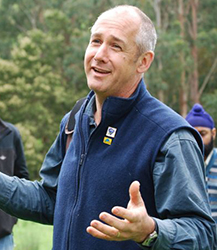Bambra Tree Sleeves
Flexible Wallaby, Kangaroo and Sheep tree guard
Developed by Rowan Reid
Watch a video on the guard HERE

Tree guards need to match the purpose: I like to graze sheep between our young trees to reduce the fire threat and control weeds. We also have problems with wallabies and kangaroos. The guards need to be cost effective and easy to assemble. There was nothing on the market that met my needs so I then set about designing a better option.
Our guard uses a 1.2m length of light plastic tube (cut from a roll) which is fed over a 2m long (8mm thick) post and fixed with 3 cable ties. A 1.8m long (10mm thick) post is available for windy sites or higher grazing pressure.
The stake has to be flexible so it returns to the upright position when battered by wind or stock. This encourages greater stem diameter growth compared to a solid post. A flexible guard is also of less value as a rubbing post for sheep. I tried a number of options for posts including 2m length of 20mm electrical conduit cut from 4m lengths. These appeared flexible and durable enough to be used a couple of times but many became bent and crooked.
Then, in a dry season, it was hard to thump the conduit into the ground. That's when I found a better post. It is a fibreglass rod with coating to prevent it degrading over time. The fibreglass is easier to bang into the ground than the conduit and, being thinner, allows more room for the tree in the tube.
Setting up the guard
These photos show the process. The seedling is planted first. Then I use a metal pipe to carefully thump the fibreglass post into the ground about 5cm away from the tree. Then I slide the tubing over the post and fix with 3 cable ties (wrapped twice around the post for firmness). If the seedling is very small (as in this case) I use a short stick or a piece of conduit to hold the tube in place and protect the seedling from the flapping plastic. Before fixing the tubing be sure that the post DOES NOT rest in the crease. If it does the tubing will close flat and can prevent hot air rising up the tube. By fixing it between the creases the tube is held open.
Left: The same tree as above (a highly palatable Sheoak) 12 months later. Right: Deciduous oak in tube after 6 months
.
I leave the guard on until the tree is large enough to stand up for itself. Then I remove the post but leave the plastic tubing on for another year or so to protect the bark from stock. Before the trunk fills the tube I cut the plastic off.
This system seems to work for a range of tree species including both natives and exotics. On very windy sites the thin posts can 'quiver' causing the plastic to tear. This is where I use the 10mm posts. The guards do allow easy follow-up weed control which is important for the slower growing species.
Cable ties can be purchased from Hardware stores or electical supplies. Use the black cable ties (UV stabalised) and wrapp then around the pole twice to get the friction required to stop them slipping up or down.
I sell the fibreglass posts and 270m long rolls of the plastic tube. The fibreglass posts are very durable and can be reused many times.
Go to our ONLINE SHOP to purchase poles and tubing
Things to watch when setting up the guard:
* I use a homemade 'thumper'. For the fibreglass posts I have a 20mm gal pipe with a cap.
* Rotate the tubing so the post DOES NOT rest in the crease before you tie it up. If the post lies in the crease the tubing will close flat. By fixing it between the creases the tube is held open
* Use a screwdriver to punch holes through the plastic tubing so you can put cable ties at the bottom, middle and top.
* Pull the cable ties VERY TIGHT being sure there is a small gap at the bottom (say 20mm) to allow air to enter the tube (add extra ties on windy sites, particularly at the bottom of the tubing). I repeat; wrap the cable tie around the post twice to ensure sufficient friction to prevent slipping, particularly on windy sites.
* If planting small seedlings use a short stick pushed into the ground opposite the post to stop the tubing moving over the seedling. I use a 40mm section of conduit for this.
* Check regularly: ensure the tubing is not blocked with grass/leaves or has moved up or down, etc. On very windy sites the tubing can be damaged and need replacing.
Tree sleeves are not the solution for everyone on all farms; be sure to match your guard to the problem. Performance may vary with stock type and behaviour, density of stocking, presense of deer or kangaroos, soil type and exposure to strong winds. PLEASE: trial 100 on a number of sites across your farm before committing to using 1000s.
